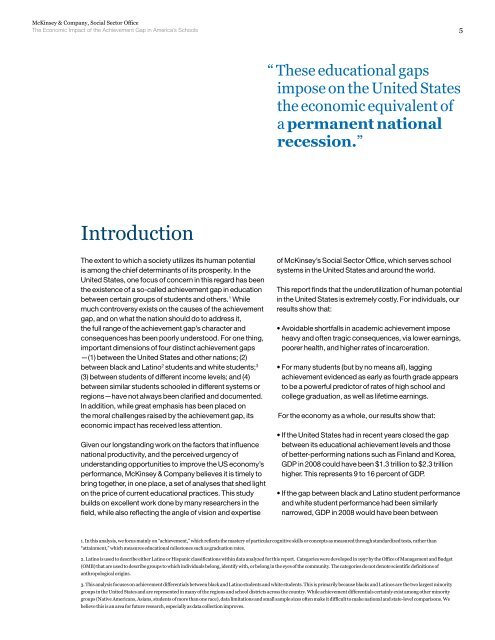Institutional Racism
Institutional Racism
Institutional Racism
Create successful ePaper yourself
Turn your PDF publications into a flip-book with our unique Google optimized e-Paper software.
McKinsey & Company, Social Sector Office<br />
The Economic Impact of the Achievement Gap in America’s Schools 5<br />
“ These educational gaps<br />
impose on the United States<br />
the economic equivalent of<br />
a permanent national<br />
recession.”<br />
Introduction<br />
The extent to which a society utilizes its human potential<br />
is among the chief determinants of its prosperity. In the<br />
United States, one focus of concern in this regard has been<br />
the existence of a so-called achievement gap in education<br />
between certain groups of students and others. 1 While<br />
much controversy exists on the causes of the achievement<br />
gap, and on what the nation should do to address it,<br />
the full range of the achievement gap’s character and<br />
consequences has been poorly understood. For one thing,<br />
important dimensions of four distinct achievement gaps<br />
—(1) between the United States and other nations; (2)<br />
between black and Latino 2 students and white students; 3<br />
(3) between students of different income levels; and (4)<br />
between similar students schooled in different systems or<br />
regions—have not always been clarified and documented.<br />
In addition, while great emphasis has been placed on<br />
the moral challenges raised by the achievement gap, its<br />
economic impact has received less attention.<br />
Given our longstanding work on the factors that influence<br />
national productivity, and the perceived urgency of<br />
understanding opportunities to improve the US economy’s<br />
performance, McKinsey & Company believes it is timely to<br />
bring together, in one place, a set of analyses that shed light<br />
on the price of current educational practices. This study<br />
builds on excellent work done by many researchers in the<br />
field, while also reflecting the angle of vision and expertise<br />
of McKinsey’s Social Sector Office, which serves school<br />
systems in the United States and around the world.<br />
This report finds that the underutilization of human potential<br />
in the United States is extremely costly. For individuals, our<br />
results show that:<br />
Avoidable shortfalls in academic achievement impose<br />
heavy and often tragic consequences, via lower earnings,<br />
poorer health, and higher rates of incarceration.<br />
For many students (but by no means all), lagging<br />
achievement evidenced as early as fourth grade appears<br />
to be a powerful predictor of rates of high school and<br />
college graduation, as well as lifetime earnings.<br />
For the economy as a whole, our results show that:<br />
If the United States had in recent years closed the gap<br />
between its educational achievement levels and those<br />
of better-performing nations such as Finland and Korea,<br />
GDP in 2008 could have been $1.3 trillion to $2.3 trillion<br />
higher. This represents 9 to 16 percent of GDP.<br />
If the gap between black and Latino student performance<br />
and white student performance had been similarly<br />
narrowed, GDP in 2008 would have been between<br />
1. In this analysis, we focus mainly on “achievement,” which reflects the mastery of particular cognitive skills or concepts as measured through standardized tests, rather than<br />
“attainment,” which measures educational milestones such as graduation rates.<br />
2. Latino is used to describe either Latino or Hispanic classifications within data analyzed for this report. Categories were developed in 1997 by the Office of Management and Budget<br />
(OMB) that are used to describe groups to which individuals belong, identify with, or belong in the eyes of the community. The categories do not denote scientific definitions of<br />
anthropological origins.<br />
3. This analysis focuses on achievement differentials between black and Latino students and white students. This is primarily because blacks and Latinos are the two largest minority<br />
groups in the United States and are represented in many of the regions and school districts across the country. While achievement differentials certainly exist among other minority<br />
groups (Native Americans, Asians, students of more than one race), data limitations and small sample sizes often make it difficult to make national and state-level comparisons. We<br />
believe this is an area for future research, especially as data collection improves.

















